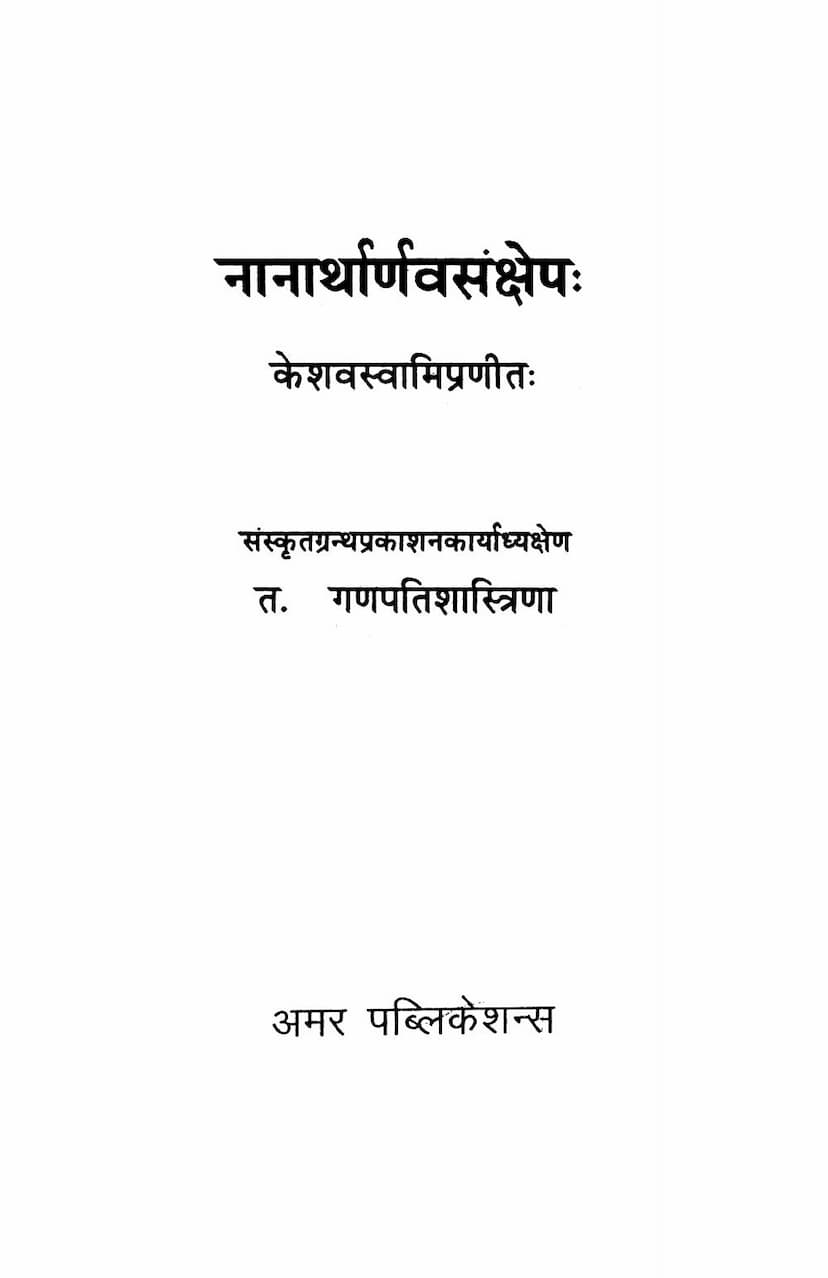Nanartharnav Sankshep
Added to library: September 2, 2025

Summary
This document is the Nanartharnav Sankshep (नानार्थार्णवसंक्षेपः), a Sanskrit lexicon authored by Keshav Swami (केशवस्वामी) and edited by T. Ganapati Shastri (त. गणपतिशास्त्रिणा). It was published by Amar Publication (अमर पब्लिकेशन्स).
The preface indicates that this edition is based on six palm-leaf manuscripts written in Malayalam script. The Nanartha words, which are homonyms with multiple meanings and varying genders (lingas), are systematically organized into six Kandas (काण्डः). The Kandas are structured by the number of syllables in the words, starting with one-syllable words in the first Kanda and progressing to six-syllable words in the sixth.
Each Kanda is further divided into five Adhyayas (अध्यायः), classified by gender:
- Strilinga (स्त्रीलिङ्ग) - Feminine
- Pullinga (पुल्लिङ्ग) - Masculine
- Napumsakalinga (नपुंसकलिङ्ग) - Neuter
- Vachyalinga (वाच्यलिङ्ग) - Gender based on meaning/reference
- Nanalinga (नानालिङ्ग) - Various genders
Within each Adhyaya, words are arranged alphabetically for ease of reference. The text boasts of including words and meanings not found in other common lexicons like the Amarakosa.
The preface also provides historical context, stating that the work was composed by Keshavaswamin, a Chhandoga Brahmin from Rajendra Chola village, at the instance of a Chola King named Sri Rajaraja, son of Sri Kulottunga Chola. This connection explains another title for the work: Rajarajiya (राजराजीयापरनामा). Based on historical mentions of Chola kings, the patron is likely one of two Rajarajas who lived in the 12th or 13th century AD.
The author, Keshavaswamin, is also cited by commentators like Mallinatha and Arunachalana, who lived before him, in their commentaries on Mahakavyas (epic poems).
The provided text appears to contain the first two Kandas (Ekakshar Kanda and Dvyakshar Kanda), with the publisher noting that the complete work covering all six Kandas has been included in the present volume. The structure of the lexicon is detailed, explaining how genders are indicated for words and how to interpret them, especially in cases where a word might apply to multiple genders or has specific rules for gender assignment.
The latter part of the document presents the actual lexicon, starting with the Ekakshar Kanda (एकाक्षरकाण्डः) and its various Adhyayas (Strilinga, Pullinga, Napumsakalinga, Vachyalinga, Nanalinga), followed by the Dvyakshar Kanda (द्वयक्षरकाण्डः) and its Adhyayas, and then the Trayakshar Kanda (त्र्यक्षरकाण्डः) and its Adhyayas. Each entry lists a word and its associated meanings and genders. The text continues through Chaturakshar Kanda (चतुरक्षरकाण्डः) and Panchakshar Kanda (पञ्चाक्षरकाण्डः), and finally Shadakshar Kanda (षडक्षरकाण्डः), all structured by gender.
In essence, the Nanartharnav Sankshep is a comprehensive and scholarly attempt to compile and organize homonyms and their gender variations in Sanskrit, providing a valuable resource for understanding the nuances of the language.